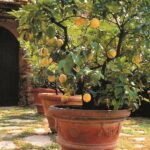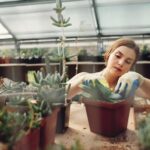Gardening in containers offers a versatile and convenient way to cultivate a bountiful vegetable garden, especially for those with limited outdoor space or poor soil quality. In this article, we will explore various gardening container ideas for vegetables that can inspire both seasoned gardeners and beginners alike. From selecting the right containers to choosing the best vegetables to grow, we will provide all the essential information needed to kickstart your container vegetable garden.
One of the key advantages of container gardening is the ability to control growing conditions more effectively. By utilizing containers, you can easily adjust factors such as soil quality, drainage, and sunlight exposure to cater to the specific needs of your vegetables. Furthermore, container gardening allows for greater mobility, making it ideal for individuals who may need to relocate their plants based on seasonal changes or space limitations.
Whether you are looking to grow tomatoes on your balcony or lettuce on your patio, there are numerous options when it comes to selecting containers for your vegetable garden. From traditional clay pots to innovative self-watering planters, each type of container has its unique benefits and considerations. By understanding these differences and choosing the right containers for your specific needs, you can create an optimal environment for your vegetables to thrive and flourish.
Benefits of Gardening Vegetables in Containers
Gardening vegetables in containers offers numerous benefits that make it an attractive option for both experienced gardeners and beginners alike. Here are some advantages to consider:
- Space-saving: Container gardening is ideal for those with limited space, such as small patios, balconies, or even indoor areas.
- Portability: Containers can be moved around easily to optimize sunlight exposure and protect plants from harsh weather conditions.
- Weed control: Since container gardening typically uses potting soil, which is weed-free, you can focus more on nurturing your vegetable plants rather than battling unwanted weeds.
Additionally, the use of gardening containers allows for better control over soil quality and drainage compared to traditional in-ground gardening. This means you can tailor the growing environment to suit the specific needs of each vegetable you choose to cultivate.
When selecting containers for your vegetable garden, consider factors such as size, material (e.g. plastic, ceramic, wood), drainage holes, and mobility. Here are some container options commonly used for growing vegetables:
- Terra cotta pots: Great for herbs and smaller plants but may dry out quickly.
- Vegetable grow bags: Lightweight and breathable, providing excellent aeration for roots.
- Raised beds: Perfect for larger crops like tomatoes and peppers while also reducing bending and kneeling during maintenance.
By utilizing the right containers based on the type of vegetables you plan to grow, you can optimize growth conditions and ensure a successful harvest. Experimenting with different container types can also add visual interest to your vegetable garden while maximizing its productivity. Just remember to regularly check on your plants’ water and nutrient needs to help them thrive in their contained environment.
Choosing the Right Containers for Your Vegetable Garden
When it comes to gardening in containers, choosing the right pots or containers for your vegetable garden is crucial for the success of your plants. The first thing to consider when selecting containers is the size. Make sure that your chosen containers are deep enough to accommodate the root systems of the vegetables you plan to grow. Vegetables like tomatoes and peppers, for instance, require larger containers compared to herbs or lettuce.
Additionally, consider the material of the containers. Clay pots are classic and aesthetically pleasing, but they can dry out quickly and may need more frequent watering. Plastic pots are lightweight and retain moisture well, making them a practical choice for beginners or those with a busy schedule. For a sustainable option, you can also opt for biodegradable pots made from materials like coconut coir or rice hulls.
Lastly, think about drainage when selecting containers for your vegetable garden. Proper drainage is essential for preventing waterlogged soil, which can lead to root rot in your plants. Make sure that your containers have drainage holes at the bottom to allow excess water to escape freely. If you want to repurpose non-traditional items like buckets or crates as planters, be sure to drill holes in the bottom before planting to ensure adequate drainage for your vegetables.
By carefully considering factors such as size, material, and drainage when choosing containers for your vegetable garden, you can set yourself up for a successful harvest of fresh produce right at home. Experiment with different types of gardening container ideas vegetables to find what works best for your space and needs, and enjoy watching your edible garden thrive throughout the growing season.
Best Vegetables to Grow in Containers
Tomatoes
Tomatoes are one of the most popular vegetables to grow in containers due to their versatility and productivity. They thrive in containers as long as they receive ample sunlight, water, and support for their vines. Varieties like cherry tomatoes or patio tomatoes are great options for smaller spaces, while larger varieties may require bigger containers.
Peppers
Peppers, whether sweet or hot varieties, are excellent candidates for container gardening. They require a warm and sunny spot to flourish and benefit from regular watering. Peppers also add a pop of color to your container garden with their vibrant hues, making them both visually appealing and delicious additions to your meals.
Herbs
While technically not vegetables, herbs like basil, parsley, mint, and chives are fantastic choices for container gardening. They can thrive in small spaces and provide fresh flavors to your dishes. Herbs do well in both individual containers or mixed with other vegetables in larger pots, providing a beautiful and aromatic addition to your garden setup.
By choosing the right vegetables for container gardening like tomatoes, peppers, and herbs, you can enjoy a bountiful harvest even in limited space. These veggies not only offer fresh produce but also enhance the aesthetics of your outdoor or indoor garden. With proper care and attention to their specific needs, you can successfully grow a variety of vegetables in containers and reap the rewards of your efforts throughout the growing season.
Tips for Successful Container Vegetable Gardening
Growing vegetables in containers can be a rewarding and convenient way to enjoy fresh produce right at your fingertips. To ensure successful container vegetable gardening, there are some tips and tricks to keep in mind.
Choose the Right Container
When selecting containers for your vegetable garden, opt for ones that are large enough to accommodate the root system of the plants. Make sure the containers have drainage holes to prevent waterlogging, which can lead to root rot. Additionally, consider the material of the container – options such as plastic, ceramic, or wooden containers can all work well for growing vegetables.
Select the Appropriate Soil
Using high-quality potting mix is essential for container vegetable gardening success. Look for a well-draining mix that is specifically formulated for vegetables in containers. Avoid using regular garden soil, as it can become compacted and hinder root growth. Consider adding compost or slow-release fertilizer to provide nutrients to your vegetable plants throughout the growing season.
Water and Sunlight Requirements
Proper watering and sunlight are crucial for healthy vegetable growth in containers. Ensure that your containers receive adequate sunlight based on the specific requirements of the vegetables you are growing. Water consistently, checking soil moisture levels regularly – containers tend to dry out faster than traditional garden beds. Adjust watering frequency based on weather conditions to prevent under or over-watering.
By following these tips, you can set yourself up for success with your container vegetable garden and enjoy a bountiful harvest of fresh produce right at home. Whether you have limited space or simply prefer the convenience of having veggies within arm’s reach, container gardening offers endless possibilities for growing your favorite vegetables with ease and style.
Creative Container Gardening Ideas for Small Spaces
Container gardening is an excellent solution for individuals with limited outdoor space. When it comes to growing vegetables in containers, the options are endless and the results can be incredibly rewarding.
One of the key benefits of container gardening is that it allows you to maximize your space by utilizing vertical areas such as balconies, patios, or even windowsills. Moreover, it provides flexibility in terms of moving the containers around to optimize sunlight exposure or protect the plants from harsh weather conditions.
When selecting containers for your vegetable garden, consider factors such as size, drainage holes, material, and mobility. Larger containers are generally better suited for vegetables with deep roots like tomatoes and peppers, while smaller pots are suitable for herbs and leafy greens.
Additionally, ensure that the containers have proper drainage to prevent waterlogged soil which can lead to root rot. Materials such as terracotta, plastic, or fabric pots are popular choices for vegetable container gardening due to their durability and breathability.
For those looking to get creative with their container gardening ideas for small spaces, there are plenty of innovative options available. Vertical gardens using hanging baskets or wall-mounted planters can save valuable floor space while still allowing you to grow a variety of vegetables.
Consider repurposing objects like old tires, wooden crates, or even mason jars to add a unique touch to your container garden. The key is to think outside the box and tailor your gardening containers according to your space constraints and personal style.
| Benefits of Container Gardening | Creative Gardening Ideas for Small Spaces |
|---|---|
| Maximizes limited outdoor space | Vertical gardens with hanging baskets/wall-mounted planters |
| Flexibility in optimizing sunlight exposure and mobility | Repurposing objects like old tires/wooden crates/mason jars |
| Allows growing a variety of vegetables in diverse settings |
Whether you opt for a traditional approach or decide to get crafty with DIY projects, container gardening offers endless possibilities for growing vegetables even in the smallest of spaces. By incorporating a mix of different container styles and sizes along with some creativity and resourcefulness, you can create a lush and bountiful vegetable garden right at your doorstep.
Remember that the success of your container garden ultimately depends on providing the right care and maintenance regimen along with regularly monitoring the growth progress of your beloved plants. Get ready to embark on an exciting journey into the world of gardening container ideas vegetables – where every harvest brings a sense of fulfillment and joy.
Maintenance and Care for Container-Grown Vegetables
Maintaining and caring for your container-grown vegetables is essential to ensure they thrive and produce a bountiful harvest. Here are some key tips to keep in mind:
- Watering: Proper watering is crucial for container vegetables as they can dry out quickly. Ensure containers have drainage holes to prevent waterlogged soil. Water consistently, checking the moisture level regularly by sticking your finger into the soil. Adjust watering frequency based on weather conditions.
- Feeding: Container-grown vegetables need regular feeding since nutrients in the soil can deplete faster in limited spaces. Consider using a balanced liquid fertilizer or slow-release fertilizer according to package instructions. Avoid over-fertilizing, which can lead to nutrient burn.
- Pruning and Harvesting: Regular pruning helps promote healthy growth and prevents overcrowding in containers. Remove dead or yellowing leaves, suckers, and overly crowded plants. Harvest vegetables when they are ripe to encourage continuous production.
Proper maintenance also includes keeping an eye out for pests and diseases that can affect your container garden. Inspect plants regularly for any signs of pest infestations such as holes on leaves, webs, or visible insects. Treat affected plants promptly with organic pest control methods to prevent further damage.
Remember to rotate your containers periodically to ensure all sides receive adequate sunlight for even growth. Additionally, consider mulching the top layer of soil with organic materials like straw or compost to retain moisture and suppress weeds. By following these maintenance practices, you can enjoy a flourishing container vegetable garden throughout the growing season.
DIY Container Gardening Projects for Vegetables
Have you ever considered creating your own DIY gardening containers for growing vegetables? Not only can it be a fun and rewarding project, but it also allows you to customize your containers to perfectly suit your space and gardening needs. There are countless creative ideas out there for making unique and functional gardening containers, all while adding a touch of personality to your garden.
One popular DIY container gardening project for vegetables is creating a vertical herb garden using recycled materials. By upcycling old pallets or wooden crates, you can easily create a space-saving herb garden that adds both beauty and functionality to your outdoor space. Simply attach small terracotta pots or mason jars to the pallet or crate, fill them with soil, plant your favorite herbs, and hang the structure on a wall or fence for easy access to fresh herbs.
Another innovative DIY gardening container idea for vegetables is repurposing old tires into planters. Tires make great containers for larger vegetable plants like tomatoes, peppers, and cucumbers due to their size and durability.
Simply stack multiple tires on top of each other, fill them with soil, plant your vegetables, and watch them thrive in this unconventional yet effective container. Additionally, painting the tires with colorful designs can add a touch of whimsy to your garden while repurposing an otherwise discarded item.
If you’re feeling crafty, consider making hypertufa planters for your container vegetable garden. Hypertufa is a mixture of Portland cement, peat moss, and perlite that creates lightweight yet durable planters perfect for growing vegetables.
By molding the hypertufa mixture into various shapes and sizes, you can create unique containers that showcase your creativity while providing the ideal environment for your vegetable plants to grow and flourish. With these DIY container gardening projects for vegetables in mind, let your imagination run wild as you explore different ways to elevate your container garden with handmade creations tailored to your individual style and preferences.
Conclusion
In conclusion, container vegetable gardening offers a convenient and rewarding way to grow your own produce, even in limited spaces. The benefits of gardening in containers are numerous, from the flexibility to move your garden around for optimal sunlight to the ability to control soil quality and drainage. By choosing the right containers and selecting suitable vegetables for container growth, anyone can experience the joys of harvesting their own home-grown veggies.
For those looking to embark on their container vegetable gardening journey, there are plenty of creative gardening container ideas vegetables to explore. Whether it’s repurposing old buckets and crates or investing in decorative pots and hanging baskets, the possibilities are endless. Small space gardening can be both functional and aesthetically pleasing with a bit of creativity and resourcefulness.
In essence, getting started with a container vegetable garden is not only about growing fresh produce but also about nurturing a sense of accomplishment and connection with nature. So why not roll up your sleeves, gather your containers and seeds, and dive into the world of container vegetable gardening? Your taste buds will thank you for the delicious rewards that await.
Frequently Asked Questions
What Vegetables Are Best to Grow in Containers?
Vegetables that are best to grow in containers include tomatoes, peppers, lettuce, radishes, and herbs like basil and cilantro. These vegetables thrive in smaller spaces and can be easily managed within a container setup.
What Vegetables Grow Well Together in a Container?
Certain vegetables grow well together in a container due to their similar needs for sunlight, water, and nutrients. For example, combining lettuce with radishes or planting tomatoes with basil can result in a complementary relationship where they support each other’s growth.
What Is the Cheapest Container to Grow Vegetables In?
The cheapest container to grow vegetables in is often a simple plastic or clay pot that can be found at garden centers or even repurposed from household items like buckets or old storage bins. These containers offer a budget-friendly option for growing vegetables successfully.

Welcome to my gardening blog! I am passionate about plants and enjoy sharing my knowledge and experiences with others. In this blog, I will write about everything related to gardening, from tips on how to get started to updates on my own garden projects.





